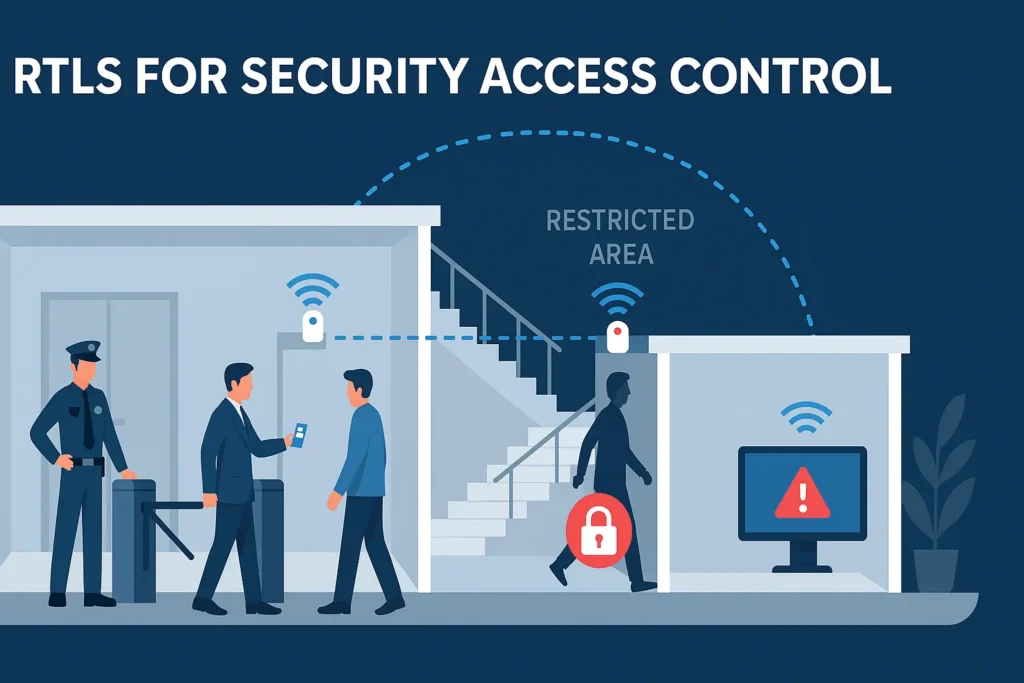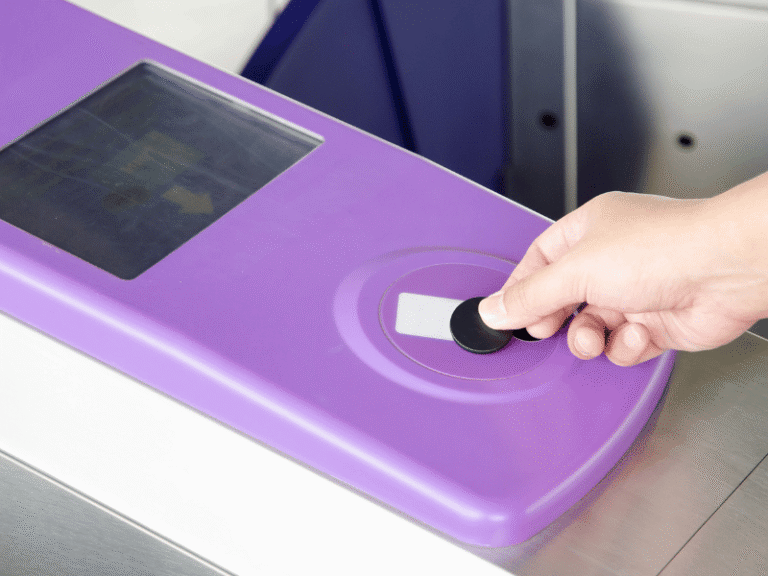Real-Time Location Systems (RTLS) are transforming how businesses secure buildings and sensitive areas by adding location-aware capabilities to traditional access control systems. Instead of relying solely on static badges or PIN codes, RTLS uses wireless tags and sensors to track people and objects in real time. This enables dynamic, context-aware security policies – for example, doors that unlock only when an authorized person with a valid RTLS tag approaches, or alarms that trigger if someone enters a zone without permission. By integrating RTLS data with access control, organizations gain continuous visibility into who is in a building and where they are, improving safety and efficiency. This approach complements other applications of RTLS (such as indoor navigation and wayfinding) by focusing on security and access management. In this guide, we explore how RTLS strengthens security access control, its benefits, real-world use cases, integration strategies, and practical considerations for deployment.

Traditional access control often depends on badges or PIN pads at each door. RTLS adds a layer of intelligence by continuously tracking the location of badges, key cards, mobile devices, or wearable tags. When combined with door readers, cameras, and security software, RTLS can automate and optimize access in ways static systems cannot. For instance, instead of tailgating concerns (where an unauthorized person follows an authorized one through a door), RTLS can detect if multiple tags pass a door and trigger an alert if only one access grant was logged. RTLS zones can be defined around secure areas; if someone enters a restricted zone without carrying an authorized tag, the system can immediately lock doors or notify guards. Conversely, authorized personnel approaching a door can have it unlock automatically, providing frictionless entry. By linking location data into the security dashboard, administrators get real-time maps of personnel movement and can retrospectively review who accessed each area at any time. This real-time insight into movements is similar to how RTLS is used in asset tracking and other applications, except here the priority is ensuring only permitted individuals can enter.
Key RTLS technologies (like Ultra-Wideband, Bluetooth Low Energy, Wi-Fi, or RFID) can be chosen based on accuracy needs. For example, Ultra-Wideband (UWB) and Angle-of-Arrival systems can achieve sub-meter precision, allowing very fine access zones (e.g. only open a specific lab door if the person is right next to it). Lower-cost solutions like BLE or Wi-Fi can suffice for broader areas. Organizations often combine RTLS tags with existing ID cards: a badge becomes a tag when embedded with a Bluetooth or RFID transmitter. This way, a staff member’s security pass performs double duty as an RTLS tag. (See our page on RTLS principles for more details.)
Continuous Tracking and Alerts: RTLS provides live data on who is where. If someone without proper credentials enters a secure zone, the system can instantly alert security teams or trigger locks. Conversely, in an emergency evacuation, RTLS can quickly report which employees or visitors remain inside a building, improving response.
Improved Tailgating Prevention: By correlating tag IDs with door events, RTLS can detect if more than one person passes a point on a single credential swipe. This real-time detection of potential tailgating or piggybacking boosts security beyond badge checks alone.
Automated Entry and Exit Logging: Rather than manual logbooks, RTLS automatically records every access event (entry/exit) with time and identity. This detailed audit trail aids compliance and investigations. For example, an RTLS report can show that “Alice Badge” passed through the server room door at 2:45 PM and left at 3:30 PM.
Enhanced Emergency Response: During lockdowns or drills, knowing the exact location of each person is critical. RTLS can support geofencing to confine people to safe areas or alert if someone strays from evacuation routes. The system might, for instance, lock down a wing if an unauthorized tag is detected, or guide fire crews to trapped individuals via their last known position.
Integration with Other Systems: RTLS can work with CCTV, intrusion alarms, and building management. For example, when an employee’s tag badges at a door, RTLS can command cameras to focus on that doorway. Or, if RTLS detects a breach, it can both trigger alarms and flash lights in the area to deter the intruder. These integrations make security proactive and data-driven.
In modern offices, employees use RFID or NFC badges for entry. With RTLS-enabled badges, the same card also tracks movement. For example, when someone scans in at a lobby turnstile, RTLS logs the entry and opens barriers. If that badge later appears in a restricted area without a valid entry, the system alerts security. RTLS also enforces rules like “office hours only” and flags mismatched swipe/location events. The result is seamless, automated security—doors open only when the correct person is present.

Factories and labs require strict safety and access control. Workers wear RTLS tags in helmets or ID cards. If an authorized technician nears secure machinery, the system logs it; unauthorized access triggers alerts. In labs, RTLS ensures only qualified personnel enter cleanrooms or high-risk zones. It can also detect inactivity in dangerous areas and alert responders. Integrating RTLS with access control enables smart, hands-free security for complex environments.
Busy venues like airports or stadiums benefit from RTLS by automating access and improving safety. Attendees at events use RTLS badges to access only their registered sessions. Transit cards with RTLS can track passenger flow and trigger smart gates. If someone without valid credentials approaches a restricted area, gates lock and staff are alerted. RTLS also supports VIP access and helps security locate threats in real time—managing thousands of tags across large sites.

RTLS secures assets as well as people. In data centers or warehouses, tagged equipment triggers alerts if moved into restricted zones. Security tools like AEDs can be tracked to prevent loss. In high-security sites, RTLS ensures containers stay within vaults, triggering alarms if boundaries are crossed. Each tag logs identity and movement for compliance and theft prevention—essential in industries like defense, pharma, and advanced manufacturing.
Successfully implementing RTLS for access control requires more than just installing hardware—it’s about seamless integration with your existing security infrastructure. RTLS solutions must communicate effectively with physical access control systems (PACS), video surveillance, HR identity platforms, and emergency response tools. Compatibility with protocols like BLE, UWB, Wi-Fi, and RFID ensures smoother deployment across diverse environments.
On the implementation side, organizations should assess infrastructure readiness, network requirements, and data privacy regulations such as GDPR or HIPAA. Real-time access data must be securely processed and stored, often necessitating IT coordination and cybersecurity reviews. Scalability is another key factor—your RTLS system should support future facility expansions or policy changes without disruption. Equally important is staff training: ensure that security teams understand how to interpret location data, manage geofences, and respond to alerts. By addressing these technical and operational considerations together, you set the foundation for a secure, compliant, and future-ready RTLS deployment.
As physical and digital security converge, RTLS adds real-time location awareness to traditional systems, turning static badges into proactive tools. It helps prevent breaches, speeds up emergency response, and enhances safety without disrupting users. Security teams get automated logs and alerts, while operations can use the same data for efficiency. RTLS works across offices, factories, hospitals, and campuses—raising safety standards everywhere. Looking ahead, integrating RTLS with AI, video analytics, or IoT will create even smarter, more responsive security. For example, RTLS can link to video feeds to quickly identify intruders or adjust access levels based on real-time movement. RTLS makes access control smarter, safer, and more adaptable than ever.
📍 We’re expanding our horizons! Stay tuned for upcoming product and service launches.📍
©2024 anyRTLS, All rights reserved.